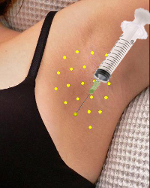Botox - diaphoresis (excessive sweating)
How it works
After injecting a small dose of botulinum toxin type A - obtained from the bacterium Clostridium botulinum - into the skin, the functioning of nerves that supply the exocrine glands is blocked, which prevents the glands from sweat release. The nerve endings block lasts from 6 to 12 months, after which new nerve endings are created, replacing the ones that had earlier been blocked. It means, that the treatment effect is visible for several months, however, it finally declines.
Still, the method is nowadays the most widely applied and recommended. Statistically, 80% of patients respond well, yet, there is a group of individuals for whom there is no effect or the effect is not satisfactory. For the remaining 20% of patients other treatment methods are advised as well as using antiperspirants.
The procedure:
 Before the procedure starts, it is necessary to specify the area of excessive sweating. Most often, the places requiring the botulinum toxin injection get visibly covered with sweat drops. However, the exact identification of the places may be sometimes very difficult, and so the Minor test (starch-iodine test) is applied. During the test, an iodine solution is applied to the skin and allowed to air-dry. Once dry the area is dusted with potato flour. After the time of several to dozen or so seconds, the sweat production areas get actively visualized, getting blackened. The identified areas of excessive sweating are then divided into squares of 1.5 x 1.5 cm with a solution such as, e.g., gentian violet.
Before the procedure starts, it is necessary to specify the area of excessive sweating. Most often, the places requiring the botulinum toxin injection get visibly covered with sweat drops. However, the exact identification of the places may be sometimes very difficult, and so the Minor test (starch-iodine test) is applied. During the test, an iodine solution is applied to the skin and allowed to air-dry. Once dry the area is dusted with potato flour. After the time of several to dozen or so seconds, the sweat production areas get actively visualized, getting blackened. The identified areas of excessive sweating are then divided into squares of 1.5 x 1.5 cm with a solution such as, e.g., gentian violet.
While the procedure, a small amount of botulinum toxin is intradermally injected into each of the squares. For most people, the treatment is very well tolerated, causing minimal pain and discomfort, however, the pain sensitive patients may receive some local anaesthesia. In general, the procedures performed on hands and feet require anaesthesia. The procedure itself is completed after a few to a dozen or so minutes and then patients may return to daily activities. The effect may be noticed after a few - a dozen or so days, it lasts from a few months up to a year (armpits). Then it requires a follow-up treatment.
Działania niepożądane
- sometimes, a local tenderness at the injection sites may occur up to a few hours,
- with excessive sweating botox treatment, there have been no complications observed, apart from a little itching in the armpit area, which ends after 1-2 weeks without curing,
- occasionally, there may occur compensatory sweating of other body areas, which also ends after a few weeks,,
- for the treatment of hand diaphoresis, a few days after the procedure, transient muscle weakness near where the medicine was injected was observed, involving the inability of abduction, especially of the little finger, less often of the thumb and execution of less strong handshake. These symptoms, however, did not interfere with daily activities in any way. Still, the condition may prove to be unacceptable for such professions like, e.g., a pianist,
- there is a little risk of experiencing flu-like symptoms (fatigue, slightly raised body temperature, muscle pain) - this discomfort subsides within a few days;
Contraindications
a) absolute:
- neuromuscular transmission disorders (myasthenia gravis, Lambert Eaton syndrome)
- hypersensitivity to any of the formula ingredients (human albumin)
- use of the following medicines or interval of up to one week after their withdrawal:
-aminoglycosides (streptomycin, gentamicin, amikacin, kanamycin, etc.)
-aminoquinolines (chloroquine, hydroxychloroquine)
-D-penicillamine (Cuprenil)
-cyclosporine
-tubocurarine, pancuronium, gallamine
-succinylcholine
-lincomycin, tetracycline, polymyxin - local infection of the skin
- pregnancy, lactation
b) relative:
- coagulation disorders
- use of anticoagulative medicines (e.g. aspirin)

